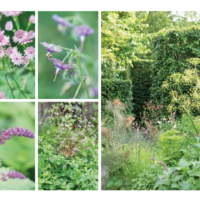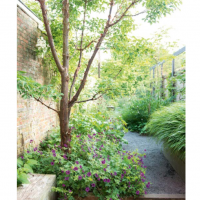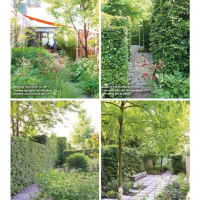Tom de Witte has been a keen gardener since he was young. “I have been familiar with planting plans since I was 12,” he says. “A couple of months after I got my driving licence, I borrowed my mum’s car and drove to Hummelo to meet Piet Oudolf. It was a three-hour drive, so it was quite a journey for me.” A career in gardening seemed inevitable, and Tom now runs a well-established garden design business.
Tom’s own garden is in a small town in Zeeland, very near the Belgian border.
It occupies a long, narrow strip, averaging about four metres wide – an awkward shape but one that allows for sub division and the creation of different zones, each of which has its own special atmosphere. “The garden has an Alice in Wonderland feel,” comments Maayke de Ridder, who photographed this feature,“becauseeachsegmentissmallbut seems larger than it actually is.”
The area immediately outside the house has a small terrace that overlooks a lush green planting with several young trees: Acer griseum, the rowan Sorbus sargentianaand silk tree Albizia julibrissin, all chosen because they are compact and provide year-round interest. As Tom explains, “The acer has wonderful bark, the sorbus has flowers and berries, and the albizia has a touch of the tropics.”
The planting style here is distinctly naturalistic, with several grasses and members of the cow parsley family, both of which strongly suggest natural habitats, even though they may not necessarily be north European natives. This natural approach is emphasised by the solid oak benches Tom has installed for seating.
The rear of the garden is not dissimilar, although it is more shaded. “There are trees growing in a cemetery behind,” says Tom, “so it is quite shaded, but having them enablesmeto‘borrow’somelandscape.” Paving with relatively wide spacing filled with gravel creates a clearly defined central area. This part of the garden is reached through two contrasting zones, one dominated by beech hedging and the second by naturalistic grassy planting. The hedged area is very different in character from the rest of the garden: ascetic, even severe, the rectangular green blocks preventing a sight line through.
“You go in, but you do not know what is at the other end, so you are invited to explore,” says Tom. “This part is meant to be contemplative, a link between the flowery first part and the flowery next part of the garden – I like the idea of thecoulisse.” A coulisse is one of the flat pieces of scenery at the side of a stage in a theatre, or the gap between the scenery panels where actors can make entrances or exits. Drama builds expectation.
Narrow gardens will have a high ratio of boundary to area, so climbers are important. Some of the climbing plants here are what might be expected, such as the rose ‘Guirlande d’Amour’; others are rather daring, such as Ampelopsis megalophylla, which can be found clambering up a trellis. This rarely seen grape relative has huge divided leaves. Tom notes, “It will grow enormous but I prune it hard. I grow it because the foliage is so good and it has interesting fruit too.”
Another rarity is the tree Tetradium daniellii, which can be found in the lower, shaded garden. It too has divided foliage and the additional virtue of flowering in August and September.
The demands of designing small gardens are very particular and can often be met by making this type of precise choice. Smaller plots deserve plantsman designers every bit as much as larger ones, as Tom’s creation demonstrates.
Read the full article in PDF here




